Art & Exhibitions
See Inside Christoph Büchel’s Provocative and Symbol-Laden Show in Venice
The Swiss agitator is back at the Venice Biennale with another divisive art project, this time at Fondazione Prada.

The Swiss agitator is back at the Venice Biennale with another divisive art project, this time at Fondazione Prada.

Jo Lawson-Tancred

A surprising and often unwelcome intervention at the Venice Biennale has become something of a trademark for the Swiss provocateur Christoph Büchel. His conversion of a 10th century Catholic church into a mosque in 2015, while representing the Icelandic Pavilion, was clearly intended to rouse some kind of commotion. It succeeded in making headlines when it was labeled a safety threat and temporarily closed by local authorities.
True notoriety came four years later with Büchel’s Barca Nostra (Our Boat), the recovered wreck of a barge that sank in the Mediterranean in 2015, killing 1,100 migrants trying to make their way to Sicily. Taboo-breaking work is usually celebrated in the art world, but this divisive piece was seen by many as a step too far. Commentators described the work as “haunting” and “absolutely vile.”
Considered in this context, Büchel’s latest Venetian venture feels like a retreat from courting controversy in favor of good old fashioned conceptual art. “Monte di Pietà,” at the Fondazione Prada’s permanent space in Palazzo Ca’ Corner della Regina, riffs on one of the venue’s earlier functions as a kind of bank offering intentionally reasonable interest rates as an antidote to loan sharks between 1834 and 1969. Büchel uses the site to explore the various ways in which debt is still used as a means of power and suppression.
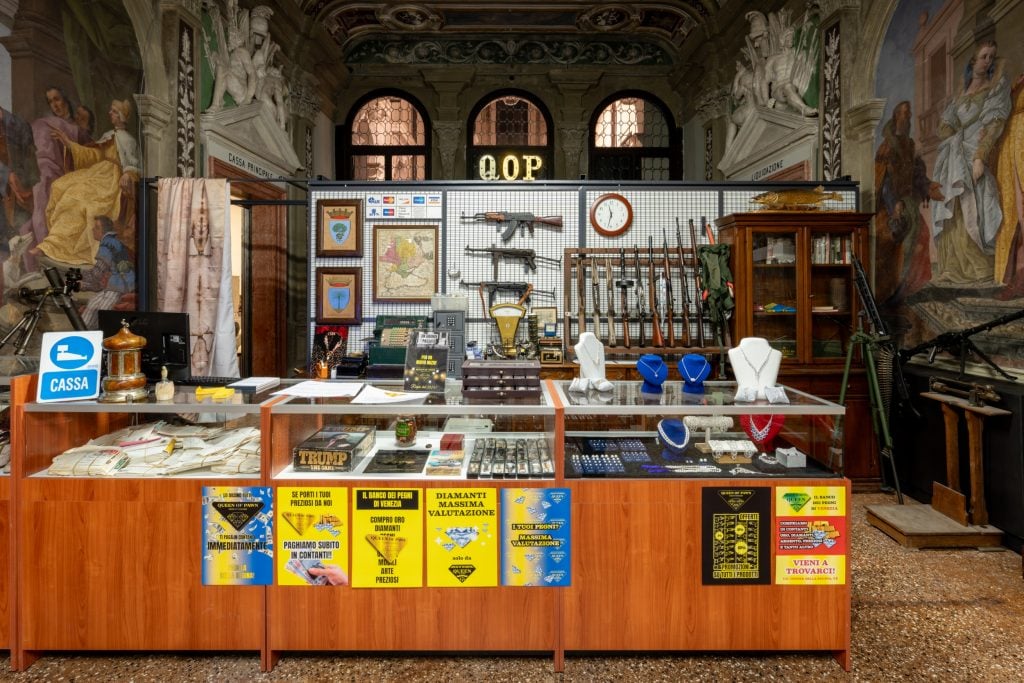
Installation view of “Monte di Pietà” by Christoph Büchel at Fondazione Prada, Venice. Photo: Marco Cappelletti.
Upon entering the immersive installation, visitors step into a bankrupt pawnshop of the modern day that is stuffed to the brim with tacky objects of dubious value. Though the initial impact of the work is immediately evocative, layered references to the history of property and wealth are to be found throughout the items on show and could reward many hours of close looking.
Through these examples, Büchel explores how debt shapes our lives as a system of control that partly traces its roots back to the kind of early mercantile activities for which the Republic of Venice was once a global hotspot. It was this that allowed the city to grow rich and bejewel itself with its grand palazzos, resplendent squares, and monumental churches. Now, of course, the arts provide the city with a whole load of soft power.
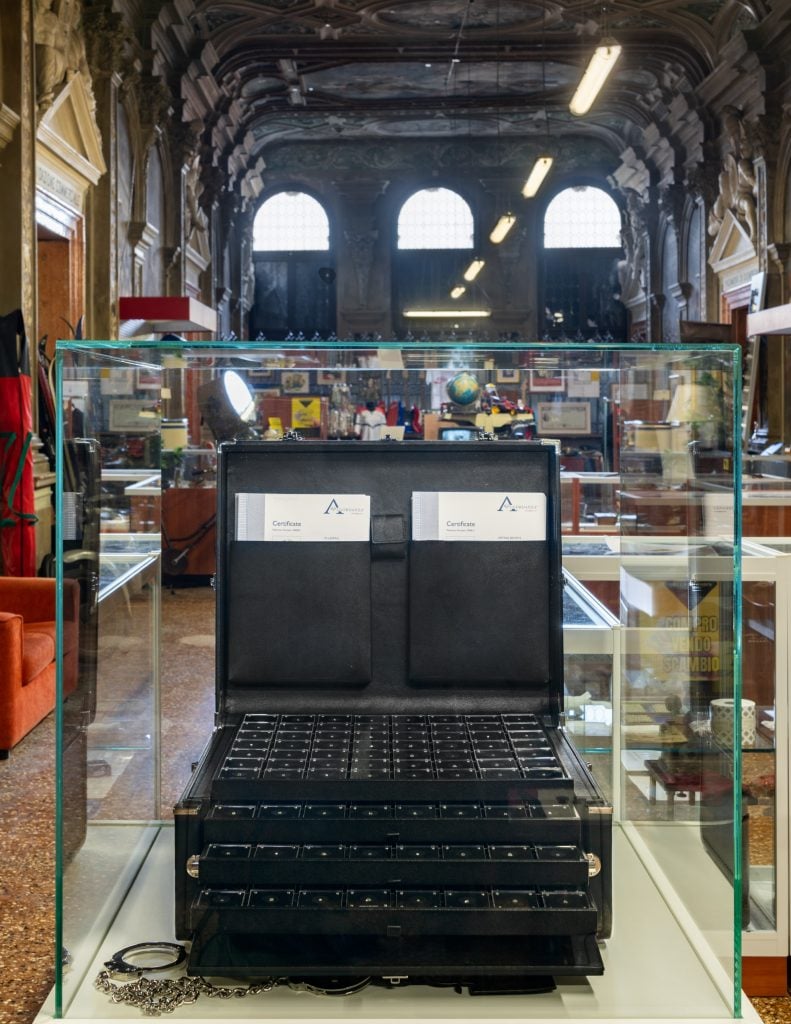
Installation view of “Monte di Pietà” by Christoph Büchel at Fondazione Prada, Venice. Photo: Marco Cappelletti.
“Monte di Pietà” also features The Diamond Maker, an open suitcase containing an array of lab-grown diamonds created by Büchel who applied heat and high pressure to extracts of organic matter from his unsold artworks and his own feces. An ongoing project since 2020, the work takes aim at the art market’s materialistic approach to constructing value. Of course, the avaricious art world is easily lured in, though not so much by shiny surfaces as by the slightest whiff of anything that claims to be transgressive.
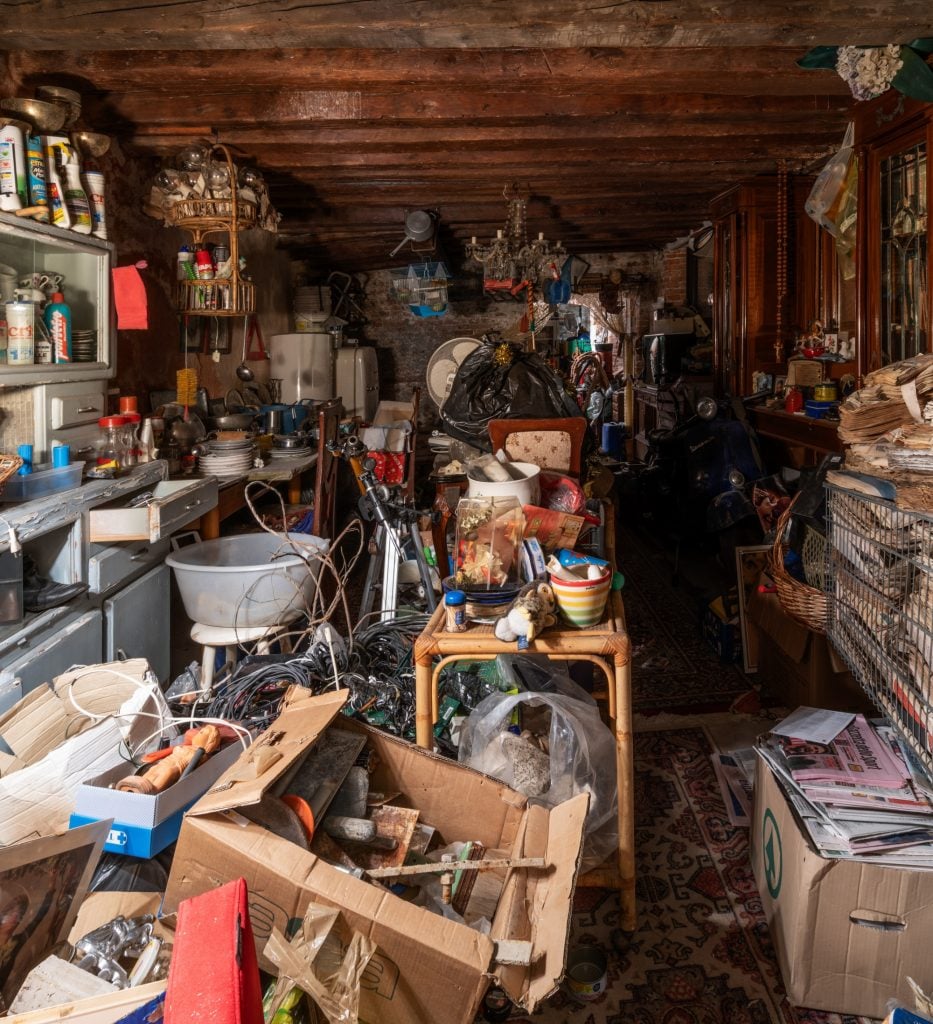
Installation view of “Monte di Pietà” by Christoph Büchel at Fondazione Prada, Venice. Photo: Marco Cappelletti.
In places, the show resembles a hoarder’s attic that has been neglected for the past 20 years. Why and how do we amass such an excess of material belongings? The detritus stacked high and overflowing out of cardboard boxes is hardly an appealing sight. Yet whole systems have been set up to peddle us this never ending tide of useless tat, as evidenced by the blankets that Büchel has laid out and adorned with the kind of knock-off bags that are apparently so tempting to tourists.
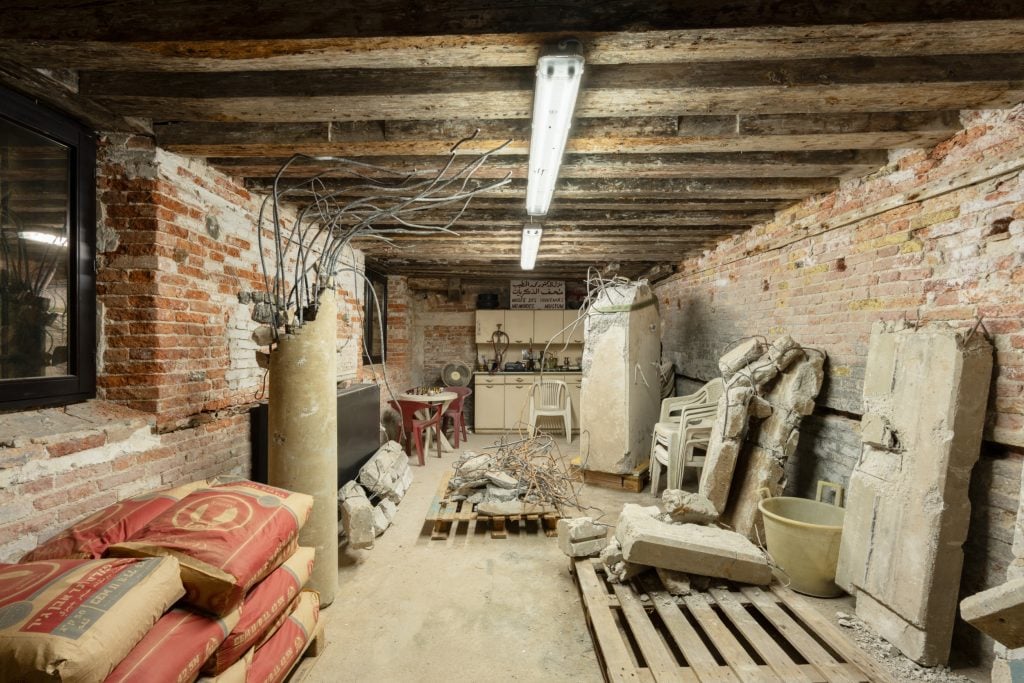
Installation view of “Monte di Pietà” by Christoph Büchel at Fondazione Prada, Venice. Photo: Marco Cappelletti.
One section of the exhibition that more obviously prods at a nerve is a dusty room of exposed brick filled with references to Israel’s war in Gaza. The space contains bags of cement from Israel, piles of rubble, a sign in Arabic for a fictitious museum of souvenirs installed above what looks like an abandoned kitchen with a radio, vessels, and hookah pipes. Most shocking of all is footage being live streamed out of Jerusalem and Gaza. True to form, Büchel’s intended meaning is left ambiguous.
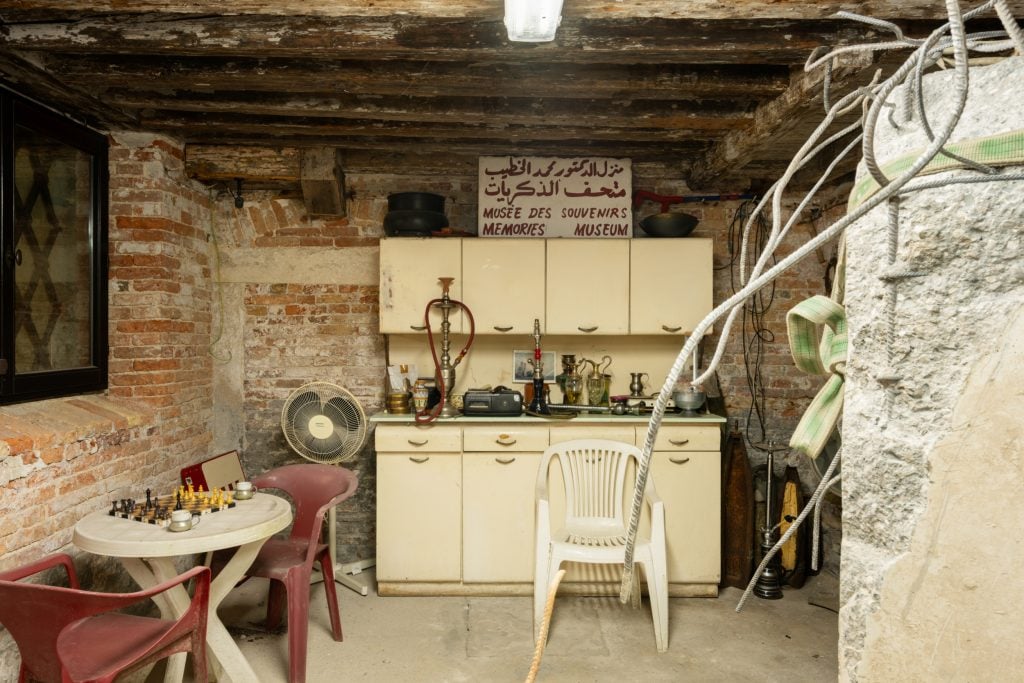
Installation view of “Monte di Pietà” by Christoph Büchel at Fondazione Prada, Venice. Photo: Marco Cappelletti.
The Palestinian artist Dima Srouji, whose work is on view at the “South West Bank” exhibition in Venice, took to Instagram to decry these elements as cheap tactics. “Watching collectors and other art professionals walking around salivating all over the show because it’s a ‘creative environment’ was enraging,” she wrote on Instagram, adding that the Biennale’s mix of protests and extravagant art world parties was often jarring. “It’s impossible to navigate these spaces. Dinners where collectors invest in art as currency while readings on Gaza happen next door.”
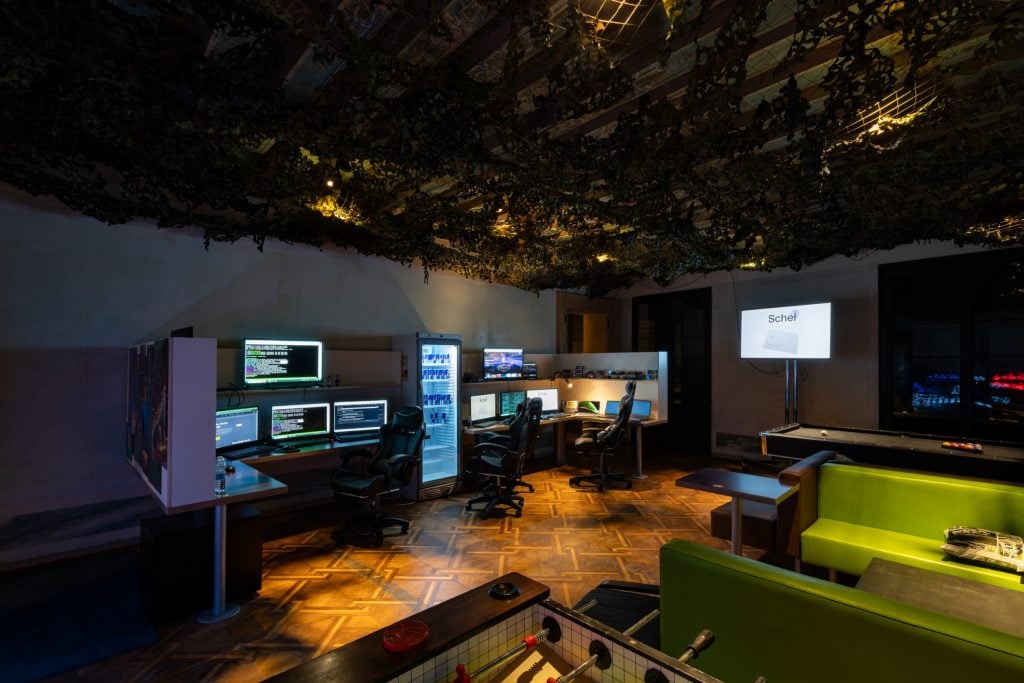
Installation view of “Monte di Pietà” by Christoph Büchel at Fondazione Prada, Venice. Photo: Marco Cappelletti.
Of course, no examination of wealth in our modern era would be complete without a reference to the creation of strangely immaterial, blockchain-based financial systems in the digital realm. To this end, Büchel has created a new cryptocurrency called Schei, which aims to incite speculation via a fake influencer account on TikTok and redistribute profits among the inhabitants of Venice.
An impressively detailed tapestry of historical and contemporary references that build a rich picture of a fast modernizing West as it galloped towards our late capitalist era, it is little wonder that such a complex work was only just installed in time for the very end of vernissage week. Nonetheless, finally open to the public last Saturday, Büchel’s show is already provoking mixed reactions and has been heralded as a standout among the many collateral offerings at this year’s Biennale.
“Monte di Pietà: A Project by Christoph Büchel” is open at the Fondazione Prada in Venice until November 24, 2024.